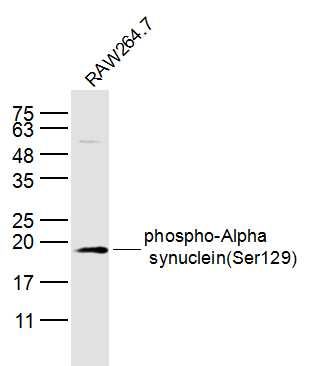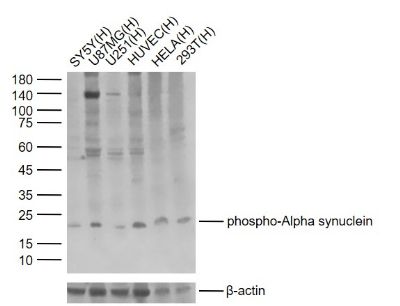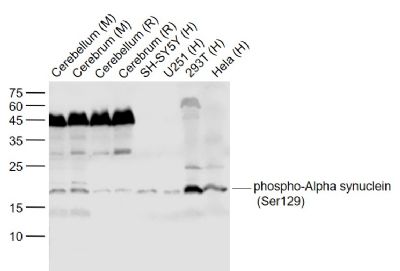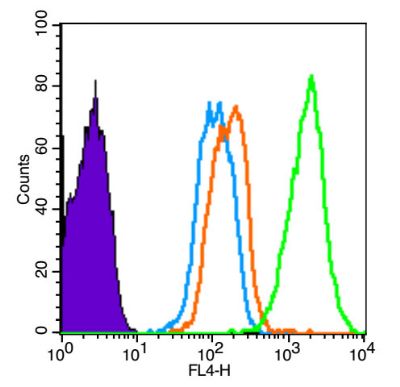Sample:
RAW264.7 (Mouse) CellLysate at 40 ug
Primary: Anti-phospho-Alpha synuclein(Ser129)(SL5628R) at 1/300 dilution
Secondary: IRDye800CW Goat Anti-Rabbit IgG at 1/20000 dilution
Predicted band size: 15 kD
Observed band size: 15 kD
Sample:
Lane 1: Human SY5Y cell lysates
Lane 2: Human U87MG cell lysates
Lane 3: Human U251 cell lysates
Lane 4: Human HUVEC Cell Lysates
Lane 5: Human HELA Cell Lysates
Lane 6: Human 293T Cell Lysates
Primary: Anti-phospho-Alpha synuclein (Ser129) (SL5628R) at 1/1000 dilution
Secondary: IRDye800CW Goat Anti-Rabbit IgG at 1/20000 dilution
Predicted band size: 15 kDa
Observed band size: 18 kDa
Sample:
Lane 1: Cerebellum (Mouse) Lysate at 40 ug
Lane 2: Cerebrum (Mouse) Lysate at 40 ug
Lane 3: Cerebellum (Rat) Lysate at 40 ug
Lane 4: Cerebrum (Rat) Lysate at 40 ug
Lane 5: SH-SY5Y (Human) Cell Lysate at 30 ug
Lane 6: U251 (Human) Cell Lysate at 30 ug
Lane 7: 293T (Human) Cell Lysate at 30 ug
Lane 8: Hela (Human) Cell Lysate at 30 ug
Primary: Anti-phospho-Alpha synuclein (Ser129) (SL5628R) at 1/1000 dilution
Secondary: IRDye800CW Goat Anti-Rabbit IgG at 1/20000 dilution
Predicted band size: 18 kD
Observed band size: 18 kD
Blank control (Black line): HUVEC (Black).
Primary Antibody (green line): Rabbit Anti-phospho-Alpha synuclein(Ser129) antibody (SL5628R)
Dilution: 3μg /10^6 cells;
Isotype Control Antibody (orange line): Rabbit IgG .
Secondary Antibody (white blue line): Goat anti-rabbit IgG-AF647
Dilution: 1μg /test.
Protocol
The cells were fixed with 4% PFA (10min at room temperature)and then permeabilized with 90% ice-cold methanol for 20 min at room temperature. The cells were then incubated in 5%BSA to block non-specific protein-protein interactions for 30 min at room temperature .Cells stained with Primary Antibody for 30 min at room temperature. The secondary antibody used for 40 min at room temperature. Acquisition of 20,000 events was performed.
|



